I have problems to solve the next exercise about maximum power transfer.

I know that potentiometer has two internal resistors. In this exercise, I must find the \$R\$ value to transfer maximum power to \$R_{L}\$. Now, I have two ideas:
To consider \$R = 500\Omega\$. If I perform it and then get Thévenin equivalent, simply \$R_{th} = 0\Omega\$ and \$V_{th} = 12V\$. Here I can't use the formula: $$ P_{max} = \frac{V_{th}^2}{4R_{th}}$$
but the transferred power to \$R_{L}\$: $$ P_{R_{L}}= \frac{(12V)^2}{100\Omega} = 1.44W$$
To assume \$500\Omega = R + R_{1}\$. In this case (\$R_{1}\$ is the other potentiometer resistor), \$R_{th} = R||R_{1} = R_{L}\$ (based on maximum power transfer theorem). I solve a quadratic equation and: $$R = (250 \pm 50\sqrt{5})\Omega\\V_{th} = \frac{12R}{500}V$$ and implies two different Thévenin voltages. Performing power calculations, I get: $$P_{R_{L}} = 36(3\pm\sqrt{5})mW$$
Definitely, the first approach gives a higher power (and suppose it's maximum power transferred by the source) , but which is correct?